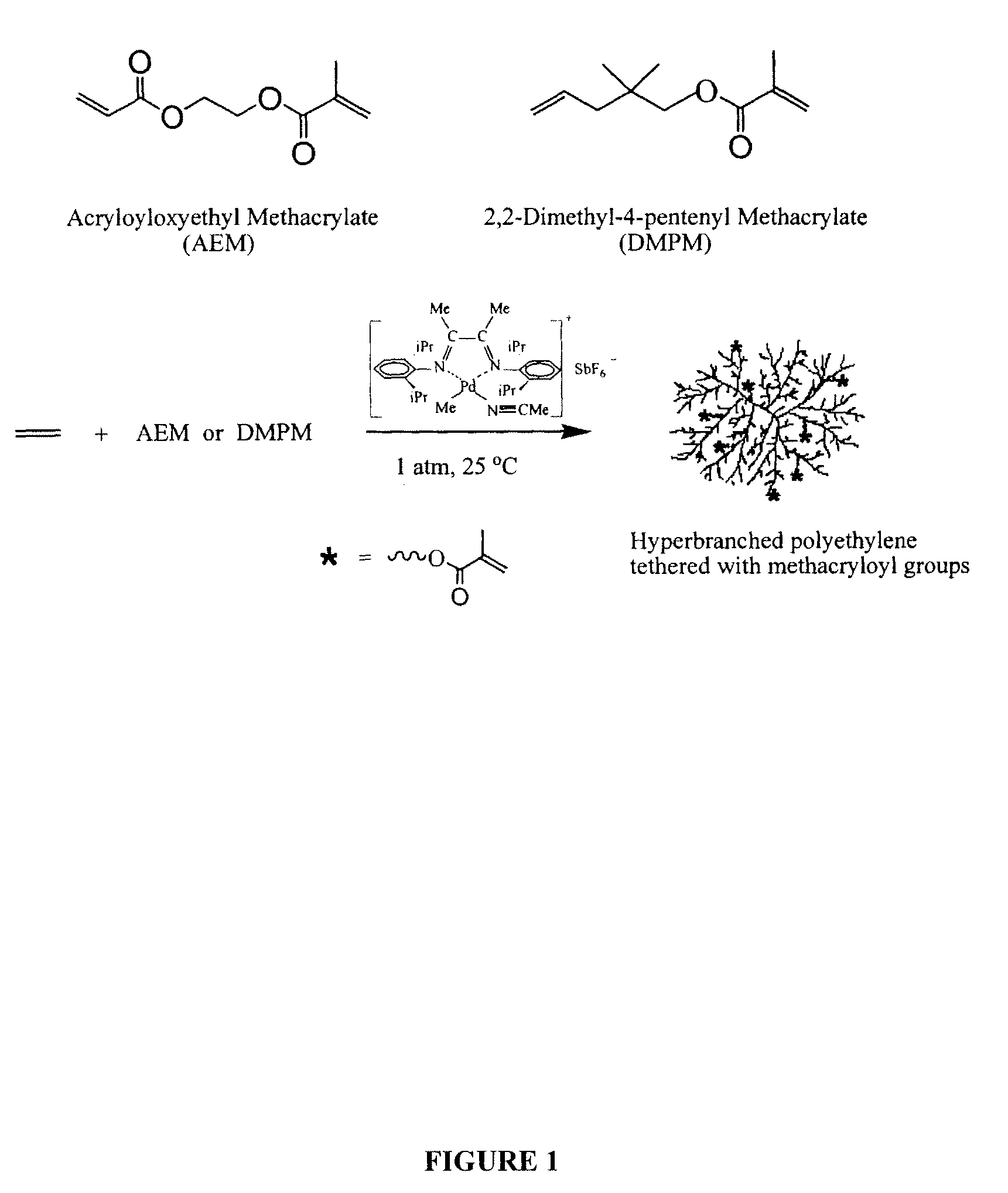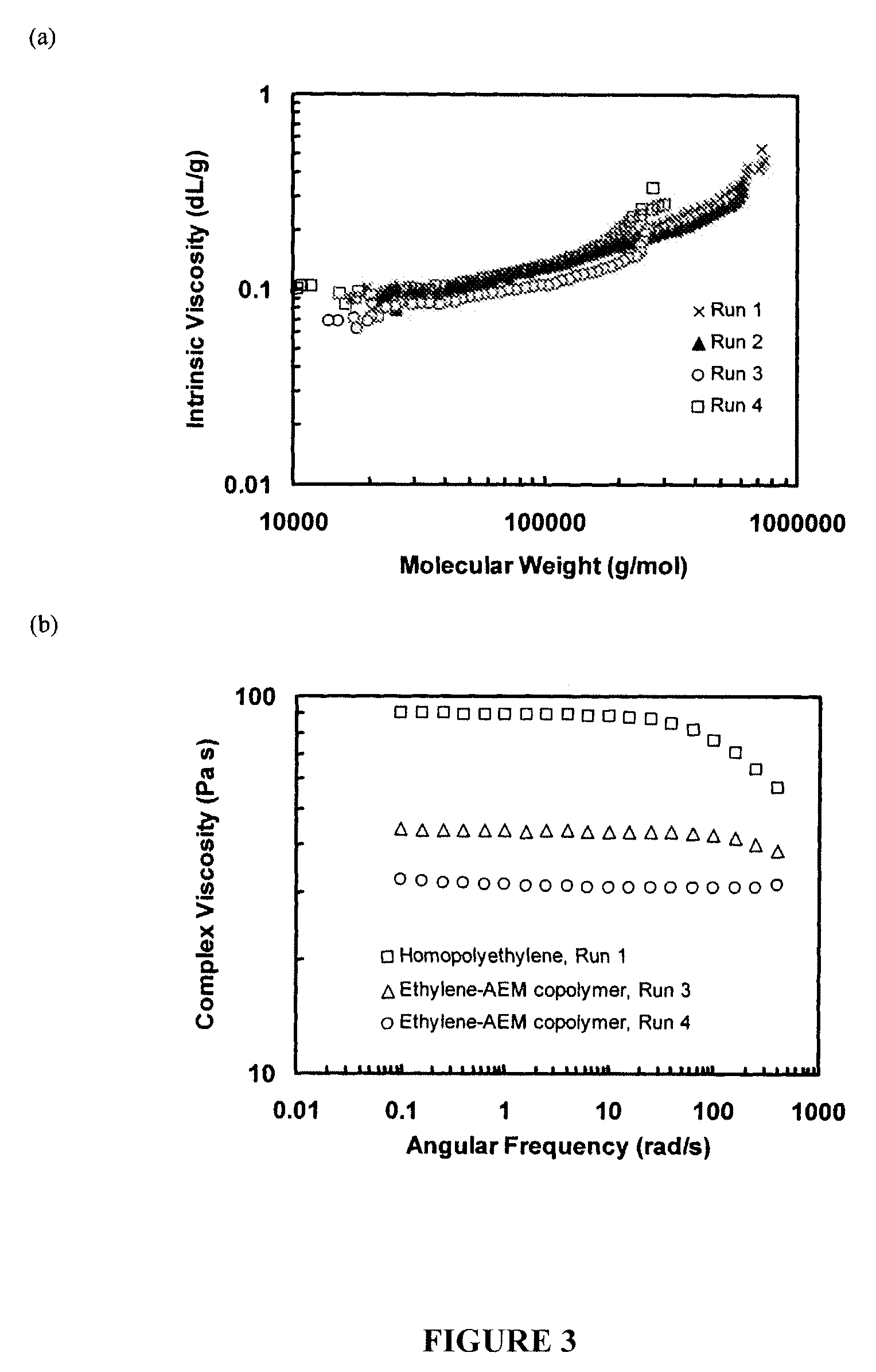Branched polyolefin polymer tethered with polymerizable methacryloyl groups and process for preparing same
a polymer and methacryloyl group technology, applied in the field ofbranched polyolefin polymers, can solve the problems of accumulative decrease in product yield and efficiency over multi-step processes, undesirable multi-step reactions, etc., and achieve the effect of easy scale up to industrial scale and simple and efficien
- Summary
- Abstract
- Description
- Claims
- Application Information
AI Technical Summary
Benefits of technology
Problems solved by technology
Method used
Image
Examples
example 1
Preparation of Hyperbranched Polyethylene Polymers Tethered with Terminal Methacryoyl Groups
[0058]Polymerization reactions Runs 1 to 5 were carried out as noted below in (a) to (e), each in the presence of the PdII α-diimine catalyst, [(ArN═C(Me)-(Me)C═NAr) PdII (CH3)(N≡CMe)]+SbF6−, wherein Ar=2,6-(iPr)2C6H3.
[0059]In each run, the polymerization reaction was carried out in a 500 mL jacketed glass reactor equipped with a magnetic stirrer, under 1 atm ethylene pressure. In each run, the jacketed glass reactor was first oven-dried, subsequently purged at least three times with ethylene, and then pressurized with 1 atm ethylene. Gaseous ethylene was used in the following examples but liquid ethylene may also be used.
[0060]A prescribed amount of anhydrous CH2Cl2 was added into the reactor. A prescribed amount of a given comonomer, methyl methacrylate (MMA), acryloyloxyethyl methacrylate (AEM) or 2,2-dimethyl-4-pentenyl methacrylate (DMPM), was added in each of Runs 2 to 5 to a final give...
example 2
Analysis of Hyperbranched Polymers
(a) 1H NMR Spectra
[0070]FIG. 2(a) shows the proton nuclear magnetic resonance (1H NMR) spectrum of the polymer produced in the presence of MMA. The spectrum is identical to that of homopolyethylene with only methyl, methylene, and methine resonances from the hyperbranched polyethylene sequences in the narrow region from 0.6 to 1.5 ppm17,18. No resonance peak due to the incorporation of MMA was found. Thus, it was concluded that MMA was not copolymerized even at a high concentration of 0.6 M. From the polymer productivity data shown in Table 1, the presence of MMA did not appear to inhibit the polymerization with a similar quantity of polymer produced compared to the control run. This was drastically different from the copolymerization of ethylene with copolymerizable acrylate and 1-alkene comonomers, where comonomer incorporation often leads to significant reduction in polymerization activity as well as the polymer molecular weight15b, 16a.
[0071]As ...
PUM
| Property | Measurement | Unit |
|---|---|---|
| Time | aaaaa | aaaaa |
| Pressure | aaaaa | aaaaa |
| Temperature | aaaaa | aaaaa |
Abstract
Description
Claims
Application Information
 Login to View More
Login to View More - R&D
- Intellectual Property
- Life Sciences
- Materials
- Tech Scout
- Unparalleled Data Quality
- Higher Quality Content
- 60% Fewer Hallucinations
Browse by: Latest US Patents, China's latest patents, Technical Efficacy Thesaurus, Application Domain, Technology Topic, Popular Technical Reports.
© 2025 PatSnap. All rights reserved.Legal|Privacy policy|Modern Slavery Act Transparency Statement|Sitemap|About US| Contact US: help@patsnap.com



